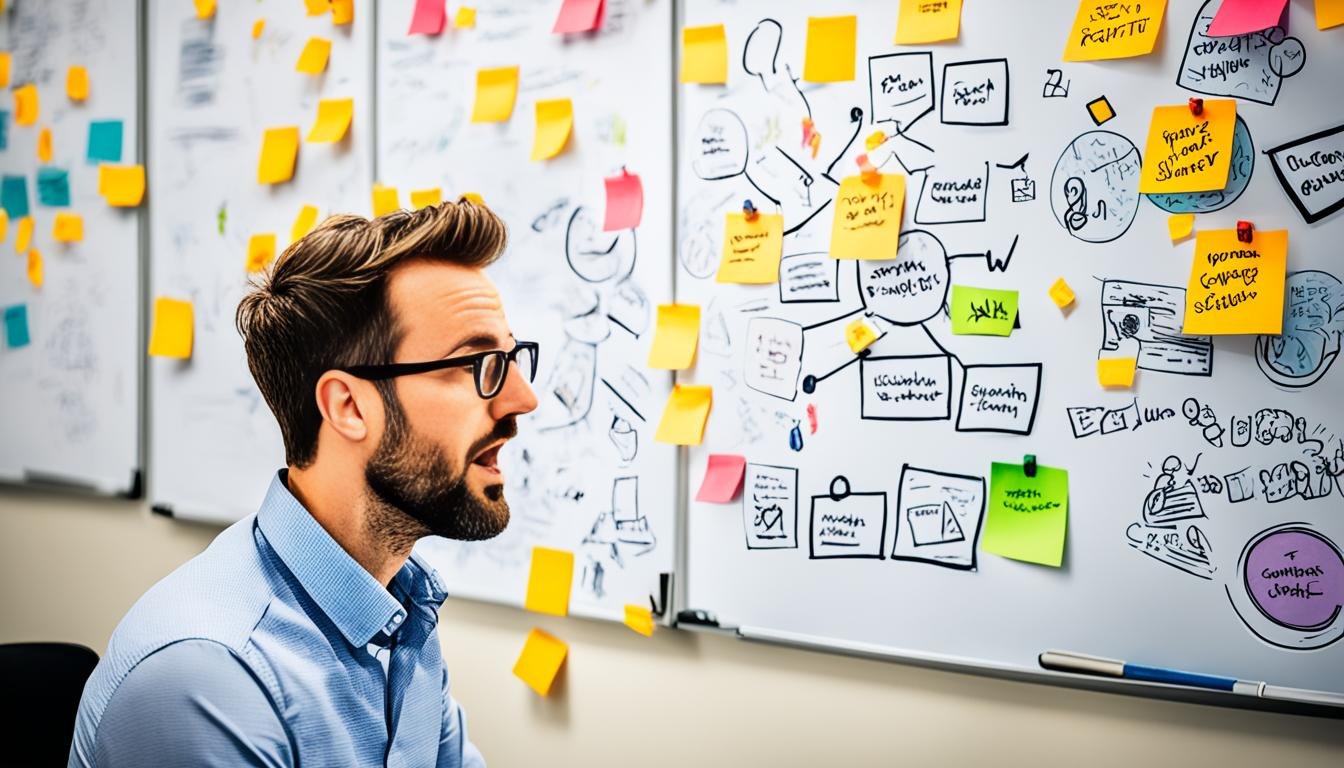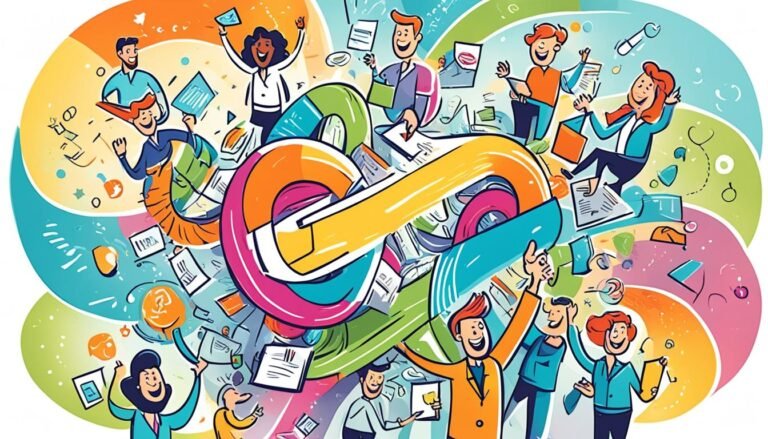Using Design Thinking to Approach Everyday Problems Creatively
Design thinking helps us solve problems in new ways. It’s a method we can use every day. This approach values creativity, working together, and always getting better. It helps us find better answers in our work and personal lives.
Key Takeaways:
- Design thinking is a human-centered problem-solving methodology.
- It encourages empathy, precise problem definition, ideation, prototyping, and iteration.
- Design thinking fosters a mindset that values innovation, collaboration, and continuous improvement.
- By applying design thinking, we can approach daily challenges with creativity and find unique solutions.
- Design thinking can be integrated into different industries and educational settings for innovative problem solving.
Understanding Design Thinking
Design thinking is a creative process. It’s about understanding others and coming up with many ideas. Then, it’s about improving those ideas through feedback and trying things out. This way of thinking helps us be more innovative and work better together. It teaches us to solve problems with fresh, creative eyes.
Embracing Human-Centered Problem-Solving
Design thinking is all about people. It says the best solutions come when we really get what others need. By putting ourselves in their shoes, we figure out what they want and what troubles them. This helps us create solutions that really work for them, building a strong link between us and those we’re trying to help.
Cultivating Ideation and Creativity
Coming up with lots of ideas is key in design thinking. This is called ideation. It’s a time to think big and think differently. We use group sessions and creative techniques to push our thoughts to new places.
“The wider the range of possibilities we consider, the more likely we are to discover innovative and transformative solutions.” – Tim Brown, CEO of IDEO.
Thinking outside the box, design thinkers shake up old ways of thinking. They find new paths that lead to major breakthroughs.
Iterative Problem-Solving for Continuous Improvement
Design thinking knows the first try might not be perfect. So, it’s about making things better after feedback and tests. This way, we keep learning and evolving our ideas. The final result is usually stronger for it.
The steps of design thinking like understanding, coming up with ideas, making prototypes, and testing keep repeating. And every round, we learn something new. This makes our solutions better and better each time.
Image
| Design Thinking Principles | Benefits |
|---|---|
| Empathy | Deep understanding of user needs |
| Ideation | Generation of diverse ideas |
| Iteration | Continuous improvement and refinement |
| Collaboration | Enhanced teamwork and collective problem-solving |
By using design thinking and its principles, we can boost our creativity. We learn to work better together and tackle complex issues in new, effective ways.
Empathy and Effective Communication
Design thinking starts with empathy. It’s about understanding and sharing how others feel. We do this by really listening to them, seeing their point of view, and acknowledging their needs. When we understand others, we connect better and can solve problems that really matter.
Empathy is a key to deeper connections. It lets us see the world from another’s perspective. Understanding their struggles and goals makes us better at saying what we mean in a way that speaks to them.
Talking and listening well is vital in design. It’s not just about making ourselves clear. It’s about understanding and meeting others where they are. Good communication with empathy builds trust and respect, key for teamwork and creativity.
“Effective communication is not just about speaking; it’s about understanding and being understood.”
With good communication, we learn from everyone. It welcomes different views and stories. These insights help us create solutions that really help everyone involved.
Adding empathy and good communication to problem-solving strengthens relationships. It makes working together easier. We’re better at understanding, cooperating and finding solutions – even in tough situations.
Design thinking reminds us to care about the people we’re helping. It says that real innovation comes from meeting their needs and dreams. The user is always at the heart of great design.
| Benefits of Empathy and Effective Communication in Design Thinking |
|---|
| 1. Enhanced understanding of user needs and perspectives |
| 2. Improved collaboration and teamwork |
| 3. Increased trust and open communication |
| 4. More holistic and innovative problem-solving |
| 5. Creation of relevant and impactful solutions |
In the end, empathy and talking well are at the core of design thinking. They connect us and help us learn from each other. By caring and sharing, we make solutions that really make a difference. With empathy and good talk, we all become better at fixing problems, working together, and creating new things.
Precise Problem Definition
Design thinking tells us to start solving problems by knowing them really well. This means we shouldn’t rush to fix things. Instead, we should take time to fully grasp what’s wrong. This way, we can make sure our work targets the real problem.
Finding the problem’s true nature is crucial. We need to look deep into it. This means understanding why the problem exists, seeing it from different views, and collecting all the important facts.
“Design thinking encourages a precise definition of the problem at hand.”
When we define the problem clearly, we avoid confusion. We make sure we’re not wasting time or resources on the wrong things. A clear problem definition guides us, making our solutions more effective.
To define problems well, we need to question things and push past assumptions. It’s about looking at the problem in new ways. We need to explore all the sides to really understand it.
Taking time for precise problem definition is key to solving problems. It helps us see the issue clearly. This leads to finding new, better solutions.
Ideation and Creativity
When the problem is clear, it’s time to get creative. During ideation, let your unusual thoughts and ideas loose. You might be solving a home problem or coming up with project ideas at work.
Ideation means thinking beyond what’s typical. It’s about using your imagination and looking at things in new ways. Embrace unusual thoughts and question the usual ways things are done. This approach can lead to new, innovative solutions.
Remember, in the ideation phase, there are no bad ideas. Each thought helps build on the creative process. So, let the ideas flow without holding back.
“The brainstorming session should be a safe space where everyone feels comfortable contributing their ideas, no matter how wild or unconventional they may seem. It’s often these unconventional thoughts that lead to groundbreaking innovations and breakthrough solutions.”
Ideation is a chance to see things differently and find new approaches. It’s about thinking outside the box. Encourage creativity and different viewpoints. This creates a big pool of ideas to work with.
Benefits of Ideation and Creativity
There are many positives to embracing creativity in problem-solving:
- By thinking up many ideas, you boost your chances of finding the best solutions.
- Unusual thoughts can lead to fresh, unseen solutions.
- Ideation helps you understand problems better, revealing their complexities and solutions.
- It drives innovation and makes new things happen.
- This process encourages working together and coming up with great team ideas.
Prototyping and Experimentation
Design thinking highlights prototyping and experimentation. It means trying different ways or testing new paths. This mindset welcomes trying and testing to find better solutions. It lets us solve problems in new ways.
Trying different strategies changes how we see things. It helps us understand their strengths and weaknesses. Exploring new ideas can help us grow and get better.
Testing new solutions gives us feedback to improve. It helps us spot issues early, so we can make our solutions better. This way, we make things that work well for people.
Prototyping and experimentation are key parts of design thinking. They help us make better decisions with real feedback.
Creating and testing new things make us learn by doing. It’s about making something to see what happens. This pushes us to find unique solutions.
Not every try will be a hit, but each one teaches us something. It gets us closer to what really works. This helps us make better choices and improve what we’ve made.
Benefits of Prototyping and Experimentation:
- Allows us to explore different approaches and perspectives
- Validates ideas and concepts
- Fosters a culture of learning and improvement
- Enables us to uncover unforeseen challenges and opportunities
- Encourages creativity and out-of-the-box thinking
Real-World Examples:
Here are some examples of how prototyping and trying new things led to big changes:
| Company | Industry | Example |
|---|---|---|
| Technology | With Google’s “20% time”, employees work on their own projects 20% of the time. This led to new products like Gmail and Google News. | |
| Amazon | Retail | Amazon tests different webpage designs to find the best one. This helps improve the website for users. |
| Tesla | Automotive | Tesla keeps improving battery tech. Thanks to this, they make cars that can go further, changing how we use cars. |
These stories show how trying new things can make something amazing. It’s about finding better ways to do things.
Being open to new ideas and testing them can lead to great solutions. It’s all about making something, then making it better. This is the path to innovation and growth.
Next, let’s dive into the role of feedback and iteration in design thinking.
Feedback and Iteration
Feedback and iteration play key roles in design thinking. They help us make our solutions better over time. This leads to more effective problem-solving and new ideas.
Feedback comes from many sources like colleagues or end-users. It gives us new insights and helps us see areas for improvement. By always looking to improve, we get closer to the best solutions.
“Design thinking is not about getting it right the first time, but about embracing the feedback loop and learning from it. It’s through this process of refining and iterating that truly innovative solutions are born.” – Jane Smith, Design Thinking Expert
When we seek feedback, it’s vital to have an environment that supports open sharing. Everyone should feel free to discuss their thoughts and ideas. This enables us to refine our solutions together and find new opportunities.
Iteration means we make small improvements based on feedback. We change and refine our solutions to make them better and more relevant. This process helps us respond to new needs and understand problems more deeply.
Benefits of Feedback and Iteration
There are many benefits to using feedback and iteration:
- By getting and using feedback, we constantly improve our solutions. This lets us find and test new ideas.
- We refine our solutions through iteration, making them more focused and efficient.
- A feedback loop encourages new thinking and sparks innovative ideas.
- Listening to end-users helps us create designs that truly meet their needs.
- Early identification of issues through iteration reduces risks of failure.
Adopting a feedback and iteration mindset powers further improvement. It allows us to refine and innovate our solutions. Through feedback, idea iteration, and an iterative process, we can fully leverage design thinking. This positively influences both our personal and work lives.
Applying Design Thinking in Daily Life
Design thinking isn’t just for designers. It’s a way to make life better. It helps us think in new ways, be more creative, and find new solutions.
This method encourages us to think differently about problems. It makes us work together and strive for better all the time. With design thinking, we find new ways to solve problems effectively.
When we face a problem, design thinking can show us new ideas. It’s about questioning what we know, seeing things from different angles, and coming up with tons of solutions.
“Design thinking gives people the tools to become co-designers of their lives.” – Tim Brown
Thinking like a designer can solve life’s problems well. It means understanding what others need and caring about their concerns.
Thinking this way also says it’s okay to try new things. We should test new ideas and adjust based on what we learn.
Using design thinking can make us better at solving problems. It also helps us be more creative and think in different ways. It’s about breaking the rules and trying new paths.
Fresh Perspectives in Action
Let’s see design thinking used in an everyday situation:
Say you want to keep your home tidy with less effort. Instead of the usual way, you think like a designer.
You start by really listening to your family’s views on cleaning. You talk openly and see what each one cares about. This helps pinpoint the real issues.
Then, you all come up with different ideas to make chores easier. Maybe a shared calendar for tasks, a reward system, or better storage. Lots of options to check out.
After that, you test these ideas to find what works best for your family. Everyone’s feedback is key. You make tweaks on what you do until it fits just right for all.
With design thinking, you do more than fix a problem. You boost teamwork, creativity, and wanting to get better in your home.

| Benefits of Applying Design Thinking in Daily Life |
|---|
| 1. Foster creativity and innovative thinking |
| 2. Approach challenges with a fresh perspective |
| 3. Develop user-centric solutions |
| 4. Enhance collaboration and communication |
| 5. Continuous improvement through iteration |
Successful Examples of Design Thinking in Various Industries
Design thinking is changing the way companies tackle tough problems across different fields. Big names like Apple, IBM, Airbnb, and Toyota are using it. They’re making new user-focused products and enhancing user experience in big ways.
Apple
Apple is known for its cool, easy-to-use tech. They use design thinking to stand out. They listen to what users want, which is always the first step in their design. Their approach brings new and life-changing tech every year. Think about the iPhone – its easy use and perfect mix of software and hardware are thanks to this strategy. These steps lead to happy users and top rankings in customer satisfaction.
IBM
IBM is a top tech and consulting company. They’re changing the game with design thinking. Their focus is on making products that are easy for anyone to use. This is clear in their data analytics, which used to be hard but is now user-friendly. They listen to customers a lot. This means they make things that help businesses grow and be smarter.
Airbnb
Airbnb is shaking up how we travel with design thinking. They started with what travelers really want. This has given us a new way to find great places to stay. Their platform makes it easy to book. It also encourages trust between hosts and guests. Plus, it builds a sense of community for travelers. All this has changed how we explore the world.
Toyota
Toyota is using design thinking to make driving better and safer. They focus on what drivers need. This leads to unique safety features, easy-to-use controls, and comfy car interiors. Their approach makes cars better for everyone. It also improves how they make cars, making the process smoother and the cars of higher quality.
These companies show how powerful design thinking can be in any business. It’s key to sparking creativity and solving tough problems. With design thinking, companies can work together well and come up with cool solutions. The world gets better products and experiences this way.
The Impact of Design Thinking in Education
Design thinking is changing how we educate. It’s a method that helps develop materials just for students. Teachers start by understanding what students really need and want. Then they get creative with their solutions.
Design thinking encourages teamwork. People from different fields join forces. This mix of ideas leads to better solutions. It’s like combining everyone’s superpowers to solve a big puzzle.
It’s all about making learning fit each student. Teachers design programs that match how students learn best. This makes learning more fun and effective for everyone.
This way of thinking doesn’t stop. Teachers always try to make their work better. They listen to feedback and make changes. This keeps things fresh and helpful for students.
Benefits of Design Thinking in Education
Here are the ways design thinking is making education better:
- It makes materials that students really connect with.
- It encourages new ideas to solve problems creatively.
- It gets teachers working together, sharing their knowledge for better solutions.
Using design thinking in schools can really shake things up. It helps prepare students for the fast-changing future.
Conclusion
Design thinking is a powerful way to solve problems in creative and new ways. It helps us see issues from different angles by using empathy and defining problems precisely. Then, through thinking up ideas, making prototypes, and refining our work, we find better answers.
This method isn’t only about solving problems. It teaches us to work together better and always improve. These benefits touch both our personal and work lives, making things better for us and those we work with.
Design thinking changes our minds to focus on working together and putting users at the center. This approach brings new ways to deal with problems, whether simple or tricky. It encourages us to be bold, think differently, and try new methods.
It’s not just about finding new solutions. Design thinking also changes how we look at and handle problems. It’s made different fields, like tech, hotels, and cars, better for users. The impact of this way of thinking shows us it can bring real change for good.
In wrapping up, design thinking is a smart way to solve problems. It lets us be more creative, work together well, and come up with cool new things. Using this in our lives helps us tackle issues in a way that brings us all forward, focusing on teamwork and improving for everyone.
Source Links
- https://www.linkedin.com/pulse/design-thinking-approach-everyday-challenges-jareena-j-oqudc?trk=article-ssr-frontend-pulse_more-articles_related-content-card
- https://www.linkedin.com/pulse/embracing-design-thinking-everyday-life-creative-jagadesh-murugaiyan-ou88c
- https://www.weartechclub.com/post/design-thinking-a-creative-approach-to-problem-solving








